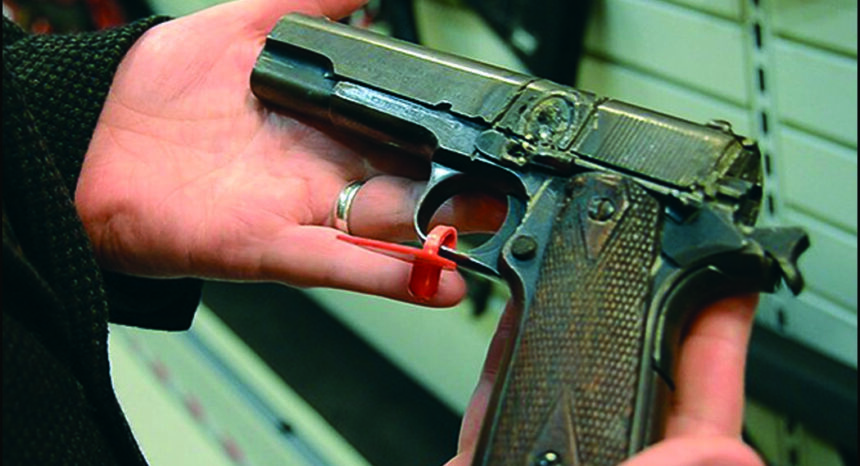N.B. A number of scholars have challenged (here and here, for example) the methodology and key findings in this study. The authors published this response in The Lancet. Journalist’s Resource is following the debate and will amend this post if necessary.
The issue: More than 92 people are killed by firearms in the United States every day, according to the U.S. Centers for Disease Control and Prevention (CDC). Though that number is far above any other developed country, and guns are used in most U.S. murders, America’s polarized political establishment has struggled to devise a solution.
In 1993, the Brady Handgun Violence Prevention Act (known often as the “Brady Law”) began requiring gun buyers to undergo a federal background check. But there are loopholes. Specifically, people can sell weapons without a license or a background check at gun shows (“the gun-show loophole”). Some states have issued separate laws intended to close those loopholes. Others have passed legislation to further deregulate gun access, such as so-called “right-to-carry” or “open carry” laws, which allow people to arm themselves in public places, including on college campuses.
A new study argues that three firearm regulations in the spirit of the Brady Law, if applied nationwide, could cut gun deaths in the U.S. by over 98 percent without any type of ban.
An academic study worth reading: “Firearm Legislation and Firearm Mortality in the USA: A Cross-Sectional, State-Level Study,” published in The Lancet, 2016.
Study summary: The authors, led by Bindu Kalesan of Boston University, built a cross-sectional, state-level study looking at a number of variables, including 25 state gun laws passed in 2009 (which “either controlled firearms or were permissive”) and CDC data on state firearm-related deaths for the years 2008 to 2010. The authors controlled for firearm ownership and other mortality data, including non-gun-related murders, to project the effectiveness of these 25 laws at a federal level.
Findings:
- Of the 25 laws passed in 2009, the authors found nine associated with reduced gun deaths, nine with increased gun deaths and seven inconclusive.
- The three laws most associated with reduced gun deaths required universal background checks to purchase a gun, background checks to purchase ammunition and that firearms carry identification — either microstamping (marking the gun with a laser) or ballistic fingerprinting (where every individual gun leaves a unique mark on a bullet).
- If these three laws were implemented nationwide, the authors predict declines in firearm-related deaths from the 2009 baseline of 10.35 per 100,000 people:
- to 4.46 per 100,000, a 57 percent decline, with universal background checks.
- to 1.99 per 100,000, down 81 percent, with ammunition background checks.
- to 1.81 per 100,000, an 83 percent reduction, with firearm identification requirements.
- to 0.16 per 100,000, with all three requirements (that is a 98.45 percent decline, though the authors do not calculate this).
- Hawaii had the lowest rate of firearm-related deaths (3.31 per 100,000) and Alaska the highest (20.3 per 100,000) in the U.S.
- So-called stand-your-ground laws — which permit individuals to respond to perceived threats with deadly force, without attempting to retreat — are associated with a “significant increase in firearm mortality.”
Helpful resources:
The U.S. Bureau of Alcohol, Tobacco, Firearms and Explosives (ATF) explains how the Brady Law works, including its temporary and permanent provisions. The Federal Bureau of Investigation (FBI) describes how its instant background checks work.
The American gun debate is often heated, with advocates on both sides offering passionate opinions and competing data. The Gun Violence Archive is a non-profit organization that grew out of a project at Slate.com. It collates gun-violence statistics and claims to take no position on the issue. The National Rifle Association (NRA) is one of the most visible lobbies for gun ownership.
This 2016 Washington Post story looks at the number of firearm-related deaths in Chicago, one of America’s most violent cities, and how those guns are brought to the city from other states.
Other research:
This 2015 study in the Annual Review of Public Health looks at efforts to keep guns out of the hands of “high-risk individuals” between 1999 and 2014 and specifically analyzes the so-called “gun-show loophole” in the Brady Law.
This 2015 paper in BMJ Injury Prevention assesses gun ownership rates across the 50 states.
This 2013 study in JAMA Internal Medicine found a correlation between state firearm legislation and lower rates of gun deaths.
This 2011 study found that murders committed with guns happen 20 times more often in America than in other developed countries.
Journalist’s Resource has written about research on right-to-carry laws, background checks and mental illness, the online gun market, shooting sprees, carrying weapons on campus and analyses of existing gun-control legislation.
Keywords: gun deaths, firearms, violence, murder, gun control


Expert Commentary